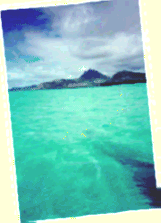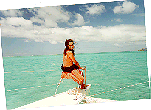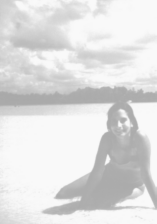


August 1995: I've just come back from a wonderful holiday in a faraway but hospitable country: the island of Mauritius. The Republic of Mauritius is in the Indian Ocean, a thousand km east of Madagascar, near the Tropic of the Capricorn, ten hours away from Italy by plane, three from South Africa and six from Perth in Australia, In this period it's two hours in front of Italy. Being below the Equator its seasons are opposite to ours: when I was there in August, that is, at the end of winter, the average temperature was of 25 degrees Celsius, that of the sea 21, a little too cold for me. Summer begins in November and lasts till April, and judging by how hot the sun was when it came out while I was there, it must be pretty boiling! It rains from January to March when it's also typhoon season. The currency is the Rupee, which is worth about 95-100 lire.
In my opinion the sea is the most beautiful thing in the island. The island is almost completely surrounded by the coral reef which produces a very weird effect: from the beach, at first you see water of a very light blue, similar to that of a well-kept swimming pool, magnificent, then at about 100 metres away you see that it has become a very dark, sometimes gray, blue and there are very tall waves that break against something invisible, while the sea on the beach side of the reef is very calm. The reef seems much closer to what it really is, because when you're in a boat you never seem to reach it.
Mauritius is a snorkelling paradise, because inside the reef the sea is only about 3 metres deep at the most. Moreover, the reef keeps sharks and similar big fish away. On the other side of the reef the seabottom drops suddenly and that's what gives the sea its deep blue colour. I've never tried deep sea diving but some friends of mine who went down 19 metres said they saw old anchors mounted in the rock, enormous fish, seahorses and red and blue coral. Where I went I only saw white coral but lots of it, on a bed of very white, fine sand. There are sea urchins that look like ours but are much bigger, with a diametre of about 20 cm, and others of normal size but purple in colour. There are also a great many starfish. The multisized fish come in many shapes and colours: black and white, black, yellow-white-black-pale blue, orange with black spots, yellow-pale blue-purple- black-grey, yellow, and fluorescent pale blue. I'm sorry but I've yet to check the species in an encyclopedia! Some friends of mine who live there said that when they go deep-sea diving during the summer they are followed by a tortoise who returns to the same spot every year. Some people in our group even saw three dolphins swimming along a river leading to a waterfall. I advise against going in a glass-bottomed boat because the fish are frightened by the engine noise and hide.
The most beautiful beach is called Belle Mare and is on the island's east coast, while the warmest one is on the opposite coast and is called Flic-en-Flac. The tourist area is in the north and reminded me of the French Riviera a bit. In winter the monsoons hit the southeastern coast near the airport, which is therefore cooler and a little overcast.
The sand on the beaches is made out of ground coral, therefore it's pure white. Corals, shells and whatever else you find on the beach is yours to take home, but it's forbidden to take anything that's alive. I advise against bending the law by taking live shells and trying to take the animal out because then they smell for a very long timeand they catch you at customs. Mauritians are taught how to preserve their enviroment at school.
The most beautiful place to go to for sea-lovers is the Ile aux Cerfs,
Deer Island, better knows as Paradise Island. It's a place that cannot be described, a
group of small islands in a lagoon of very shallow water with a tongue of sand which rises
out of the water when the tide goes out, around 3 p.m. The boats "park" near the
tongue of sand and then you walk ashore in water reaching up to your ankles. On the island
itself there are some giant tortoises inside a stone enclosure, the old inhabitants of the
place.
It's easy to book catamaran excursions to the island, which include lunch, and I really
think this is the best thing to do because it's a wonderful, fun-filled experience.
There's music, sun, sea, fish, rhum and the Mauritian boys of the crew who take really
good care of their guests.
 As for purchases, on
Paradise Island there are a number of stalls - belonging to multilingual salesmen -
selling very colourful sarongs. The prices are higher than those in the various markets
but it's difficult to find sarongs as beautiful and as varied elsewhere (I speak from
experience!). The most interesting places to buy are the markets: the largest is in Port
Louis, the capital of Mauritius, open every day till three-four o'clock in the afternoon.
It's an indoor/outdoor market divided into sections. First you encounter the meat one,
then on the right there's the fruit one and on the left clothes and household goods. The
fruit market is the noisiest and most crowded place, with the vendours shouting to attract
your attention. Vegetables are laid out in very artistic and photogenic piles: small
tomatoes, carrots, pyramids of spices, grapefruit and tropical fruit. On Sunday mornings
there's a pretty, smallish market in Flacq, near the island's eastern coast. The prices
are lower than in Port Louis but some things are not sold there. Again on Sunday, I don't
know if it's there everyday, we found quite a big market in Quatre Bornes, near the centre
of the island, but the stalls tend to be the same everywhere.
As for purchases, on
Paradise Island there are a number of stalls - belonging to multilingual salesmen -
selling very colourful sarongs. The prices are higher than those in the various markets
but it's difficult to find sarongs as beautiful and as varied elsewhere (I speak from
experience!). The most interesting places to buy are the markets: the largest is in Port
Louis, the capital of Mauritius, open every day till three-four o'clock in the afternoon.
It's an indoor/outdoor market divided into sections. First you encounter the meat one,
then on the right there's the fruit one and on the left clothes and household goods. The
fruit market is the noisiest and most crowded place, with the vendours shouting to attract
your attention. Vegetables are laid out in very artistic and photogenic piles: small
tomatoes, carrots, pyramids of spices, grapefruit and tropical fruit. On Sunday mornings
there's a pretty, smallish market in Flacq, near the island's eastern coast. The prices
are lower than in Port Louis but some things are not sold there. Again on Sunday, I don't
know if it's there everyday, we found quite a big market in Quatre Bornes, near the centre
of the island, but the stalls tend to be the same everywhere.
Bargaining is a must, although I think tourists are ripped off anyway. How can you fight
over a price which is already lower than what we're used to when the salesmen know that
we're staying in fabulous hotels?
I think the best purchases are: pareos (multicoloured and made of a type of cotton similar to silk), t-shirts (also multicoloured and made of very good, thick cotton, not like the very thin ones you buy on NY and Rome streets), Indian saris (6 metres long, if you don't want to wear them you can use the beautiful Indian material for cushions etc), fabrics of all kinds, men's shirts (pure cotton at unbeatable prices), cotton or wool jumpers (there's a shop in Curepipe, in the centre of the island, which sells them wholesale, ask where it is), rhum (the island is covered in sugar cane, so it must be good!) and lastly the island's two specialities: tablecloths hand-embroidered with small men and women working in the fields, complete with matching napkins for twelve people - they should be bought in Port Louis because they're more difficult to find elsewhere (to have an idea of the price, you should offer half of what they ask, it worked for us) - and the famous "maquettes", models of famous old ships dating back to Napoleon's time. They're hand made with incredible care. You can find both cheap versions and examples of high craftsmanship, costing several thousands of dollars. As regards prices, we paid 2/3 of what they first asked. The shop-people are also unbeatable at packing the models so that they can be taken home as handbaggage! The model I bought, the section of a ship, to be precise, I got in Curepire, where there's a shop which is also a small factory. The most famous shop that makes the models out of precious wood is, I think, in the north; everyone knows where it is, if you ask.
For nature lovers, Mauritius has one of the most beautiful and varied botanic gardens in the world. It is called Pamplemousses. Entrance is free but you have to pay if you want a guide. Without a guide we weren't able to find the famous giant waterlilies, but time was short, 45 minutes aren't enough because the garden is really huge. There are even some fenced-off areas containing giant tortoises and deer. Wandering around the island you see some striking plants: poinsettia trees, bougainvillaea of various colours, coconut trees, banana plantations, the ever-present sugarcane, flamboyant, lychees trees, filao with roots cascading from their branches and many other exotic flowers. The main crops are: sugarcane, aubergines, onions, bananas, (small but very sweet) pineapples, cotton, tobacco and tea. Fields are mainly ploughed by hand and, since the island is volcanic in origin, before doing so all the large lava stones scattered here and there must be removed. Indeed, there are heaps of them everywhere.
Mauritius is bizarre from a certain point of view, because it amalgamates French culture and lifestyle with English and Indian elements. Driving is on the left, like in Britain, the police's uniform calls to mind the British one, the official languages are French and English, and you can buy English and French products which it seems very strange to find so far away! The population is mainly Indian and there are four main religions which cohabitate very harmoniously: Hindu (characterised by the colour red), Tamil (orange), Muslim (green) and Christian (white). Taxi and busdrivers attach coloured ribbons to their vehicles to show their religion.
Between hiring a car and renting a taxi for a day, my advice is to
opt for the latter: the cost is similar and above all you won't have the stress of
driving. Mauritians drive like lunatics and it certainly isn't good for tourists to find
themselves in the way. Besides, maps show roads which look practicable but which in fact
aren't. Streets in Mauritius are not crowded with cars, something we're used to, but with
animals (stray dogs) which suddenly run out of the sugarcane plantations, cyclists, mopeds
(whose drivers use helmets but overload their vehicles) which stay put in the middle of
the road, women carrying full baskets on their heads, children playing... and so on. Since
it is allowed to move into the opposite lane to overtake buses, it's not unlikely to see
another car coming at you in a head-on collision, which miraculously manages to pull into
its own lane at the last moment!
To rent a taxi you must settle on a sum of money with the driver, based on whether you
just want to go somewhere and come back, stay out half or a full day. Taxis can carry up
to four people and taxidrivers must have a special permit to carry tourists. They can only
work for one hotel and can be found outside its gates every morning. They all speak
French, many also speak English, with a smattering of German and Italian. Our driver's
name was Vinod and he was very patient, even when we had him drive us all around the
island!
As to health problems, we didn't see any mosquitos, but there might be in the summer. No anti-malaria treatment is necessary. Water can be drunk straight from the tap but it is full of disinfectant, so you can wash your teeth with it but it's unpleasant to drink. We didn't have any stomach troubles, even though we ate everything (except from street stalls), while for instance we did get a tummy bug in Tunisia. Hotels are very clean and fully staffed. Waiters are impeccable, serving ladies first and ensuring that nothing is missing. Maybe I was struck by this service since I usually stay in small Italian hotels or American motels which certainly don't win any points in this field! One problem, however, is the lack of public restrooms. They don't exist at gas stations and they're not always accessible in restaurants. The taxidriver told us that sugarcane plantations are used for emergencies!
This is what Bernardin de Saint-Pierre said about the island in the late 18th century:
"...Excepté cette plantation on avait laissé cet enfoncement du rocher tel que la nature l'avait orné. Sur ses flancs bruns et humides rayonnaient en étoiles vertes et noires de larges capillaires, et flottaient au gré des vents des touffes de scolopendres suspendues comme de longs rubans d'un vert pourpré. Près de là croissaient des lisières de pervenche, dont les fleurs sont presque semblables à celles de la giroflée rouge, et des piments, dont les gousses couleur de sang sont plus éclatantes que le corail. Aux environs, l'herbe de baume, dont les feuilles sont en coeur, et les basilics à odeur de girofle, exhalaient les plus doux parfums. Du haut de l'escarpement de la montagne pendaient des lianes semblables à des draperies flottantes, qui formaient sur les flancs des rochers de grandes courtines de verdure. Les oiseaux de mer, attirés par ces retraites paisibles, y venaient passer la nuit. Au coucher du soleil on y voyait voler le long des rivages de la mer le corbigeau et l'alouette marine, et au haut des airs la noire frégate, avec l'oiseau blanc du tropique, qui abandonnaient, ainsi que l'astre du jour, les solitudes de l'océan indien."



Click on the graphic to vote for this
page as a Starting Point Hot Site.

Please fill in my questionnaire!

© Gabriella Marino 1995